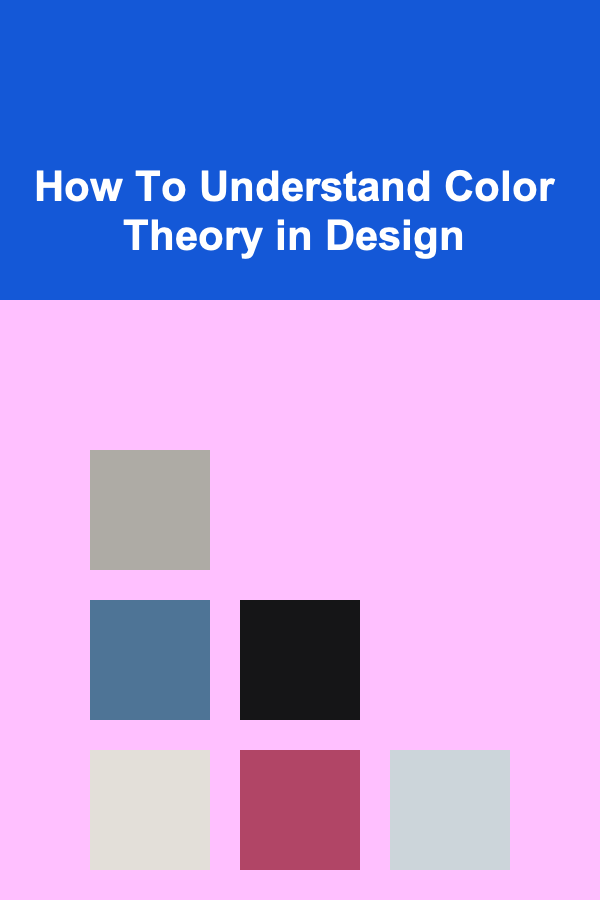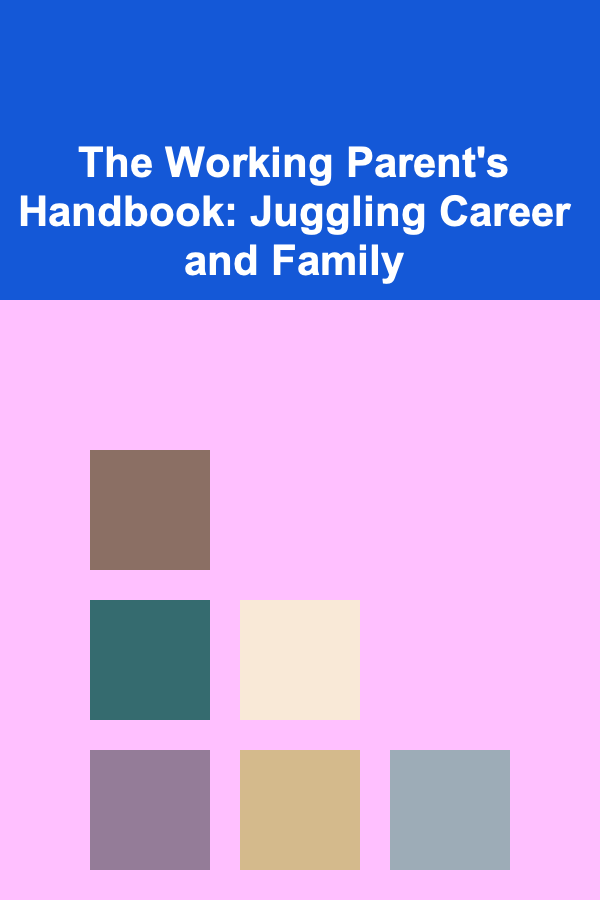
How To Understand Color Theory in Design
ebook include PDF & Audio bundle (Micro Guide)
$12.99$5.99
Limited Time Offer! Order within the next:

Color theory is an essential aspect of design that impacts the way people perceive and interact with visual content. In design, color can evoke emotions, influence perceptions, and even guide user behavior. Understanding color theory allows designers to make thoughtful and intentional choices that align with the message or emotion they wish to convey through their designs.
In this article, we will explore the foundational concepts of color theory in design, including the color wheel, the psychological impact of colors, color harmonies, and practical applications in various design disciplines. By the end, you'll have a comprehensive understanding of how to use color effectively in your design projects.
The Color Wheel: The Foundation of Color Theory
The color wheel is the cornerstone of color theory and serves as a visual representation of how colors relate to each other. It was first developed by Sir Isaac Newton in 1666 and has since become a fundamental tool for artists and designers.
Primary Colors
Primary colors are the building blocks of all other colors. These colors cannot be created by mixing other colors together. They are:
- Red
- Blue
- Yellow
These three colors are the basis from which all other colors are derived.
Secondary Colors
Secondary colors are created by mixing two primary colors in equal parts. These colors are:
- Orange (Red + Yellow)
- Green (Blue + Yellow)
- Purple (Red + Blue)
Tertiary Colors
Tertiary colors are formed by mixing a primary color with a secondary color. These are the six colors located between the primary and secondary colors on the color wheel:
- Red-Orange
- Yellow-Orange
- Yellow-Green
- Blue-Green
- Blue-Purple
- Red-Purple
The color wheel is often displayed in a circular form, with primary, secondary, and tertiary colors arranged in a way that helps designers understand how colors interact and complement each other.
The Psychology of Color: Understanding Emotional Responses
Color is not just a visual tool; it is also a powerful psychological trigger. Different colors evoke specific emotions, associations, and reactions. By understanding these emotional responses, designers can create designs that resonate with their audience on a deeper level.
Red
Red is often associated with strong emotions such as passion, love, and excitement. It can also represent danger, anger, or urgency. In design, red is frequently used to capture attention or create a sense of excitement. It is often used in call-to-action buttons, sale signs, and logos for brands that want to project energy or strength.
Blue
Blue is a calming and serene color, often associated with trust, professionalism, and stability. It evokes feelings of tranquility, reliability, and security. This is why blue is commonly used by corporate brands, healthcare institutions, and financial organizations. Lighter shades of blue can also convey a sense of calm, while darker blues exude authority and trustworthiness.
Yellow
Yellow is a bright and cheerful color that symbolizes happiness, positivity, and energy. However, it can also be associated with caution or anxiety. Designers often use yellow to grab attention or to convey optimism and friendliness. It is a common color in marketing materials targeted at children or to highlight important information.
Green
Green is the color of nature, symbolizing growth, health, and tranquility. It is often used in designs related to the environment, sustainability, or wellness. Green can also represent wealth or financial growth, which is why it is commonly used by banks or businesses in the finance industry.
Purple
Purple is traditionally linked with royalty, luxury, and creativity. It evokes a sense of elegance and sophistication, while also being associated with mystery and spirituality. Purple is often used in high-end branding or designs that aim to convey creativity, originality, or luxury.
Orange
Orange combines the energy of red with the happiness of yellow. It is associated with enthusiasm, creativity, and warmth. Orange can be used to create a sense of excitement and friendliness, making it a popular choice for designs that want to appear approachable, youthful, and fun.
Black
Black is the color of sophistication, elegance, and authority. It is often used in luxury branding, high-fashion designs, and to create a sleek, modern aesthetic. Black can also symbolize power or mystery. While it is a versatile color, it should be used carefully, as it can also evoke feelings of sadness or negativity if overused.
White
White represents purity, simplicity, and cleanliness. It is often used in minimalist design to create a sense of openness and clarity. White can also evoke feelings of innocence or peace. It is commonly used in healthcare, tech, and luxury brands to communicate clarity and simplicity.
Brown
Brown is a warm, earthy color that is often associated with stability, reliability, and comfort. It can evoke feelings of nature, warmth, and security. Brown is often used in designs related to organic products, earthy brands, or designs that aim to convey trust and reliability.
Color Harmonies: Creating Balanced and Pleasing Designs
Color harmonies refer to the strategic use of color combinations to create aesthetically pleasing and balanced designs. Understanding color harmonies helps designers make intentional choices about how colors relate to each other and how they work together visually.
Complementary Colors
Complementary colors are located directly opposite each other on the color wheel. These color pairs create strong contrast and visual interest when used together. Some common complementary color pairs include:
- Red and Green
- Blue and Orange
- Yellow and Purple
When using complementary colors, it's important to balance the amount of each color to avoid overwhelming the viewer. One color should dominate the design, while the other can serve as an accent.
Analogous Colors
Analogous colors are adjacent to each other on the color wheel. These color combinations create a harmonious and unified look. Common analogous color schemes include:
- Red, Red-Orange, and Orange
- Blue, Blue-Green, and Green
- Yellow, Yellow-Green, and Green
Analogous colors work well when you want a soothing, cohesive design, as they blend together smoothly. They are ideal for designs that need a calm, relaxed atmosphere.
Triadic Colors
Triadic colors are evenly spaced around the color wheel. A triadic color scheme uses three colors that are equally spaced, creating a vibrant yet balanced palette. Some examples of triadic color combinations are:
- Red, Blue, and Yellow
- Orange, Green, and Purple
- Yellow, Blue, and Red
Triadic color schemes are versatile and can be used in a wide range of designs. They provide a dynamic, energetic look while maintaining color harmony.
Split-Complementary Colors
Split-complementary colors are a variation of complementary color schemes. Instead of using the direct opposite color, you choose the two colors adjacent to the complementary color. For example, if you choose blue as your base color, you would use red-orange and yellow-orange as your split-complementary colors.
This color scheme offers a similar level of contrast to complementary colors but is often easier to work with because it provides more flexibility and less intensity.
Monochromatic Colors
A monochromatic color scheme uses variations of a single color, such as different shades, tints, and tones of blue. This creates a harmonious, cohesive design, though it can sometimes lack contrast if not executed thoughtfully.
Monochromatic color schemes work well for minimalist or clean designs, where simplicity is key.
Practical Applications of Color in Design
Now that we've explored the foundational concepts of color theory, let's look at how these principles are applied in various design fields.
Graphic Design
In graphic design, color plays a crucial role in establishing a brand's identity, guiding the viewer's attention, and conveying the desired message. Designers often use color theory to create visually appealing layouts, advertisements, logos, and illustrations.
For example, a brand targeting young adults may use bright, energetic colors like yellow and orange to evoke feelings of excitement and positivity. On the other hand, a luxury brand might choose a more restrained color palette, using black, gold, and deep purple to convey sophistication and exclusivity.
Web Design
In web design, color is used not only for aesthetics but also to improve usability and user experience. Websites with well-thought-out color schemes help guide users through the site, emphasizing key actions like buttons, links, and navigation.
Colors can also be used to create visual hierarchies, such as using bold, contrasting colors for calls-to-action (CTAs) or using muted tones for background elements. Web designers must also consider accessibility, ensuring that text contrasts sufficiently with the background to accommodate users with visual impairments.
Fashion Design
In fashion design, color choices are crucial for conveying style, mood, and trends. Designers use color theory to create collections that appeal to their target audience and evoke certain emotions or themes. The colors chosen for a season can even influence the entire fashion industry, dictating trends and setting the tone for upcoming collections.
Interior Design
In interior design, color affects the mood and functionality of a space. Designers use color theory to select paint colors, furniture, textiles, and accessories that create a cohesive and welcoming environment. For instance, soft blues and greens are often used in bedrooms to create a calm, relaxing atmosphere, while bright reds and oranges are used in kitchens to stimulate energy and appetite.
Product Packaging
Color in product packaging plays a significant role in consumer decision-making. The colors chosen for a product's packaging can influence perceptions of quality, taste, and value. For example, eco-friendly products often feature shades of green and brown to evoke a sense of nature and sustainability, while premium products may use black or gold to convey luxury.
Conclusion
Color theory is an essential tool for designers across all disciplines. By understanding the relationships between colors, the psychological impact of each hue, and how to create harmonious color combinations, designers can craft visually appealing and effective designs that resonate with their audience.
Whether you're designing a logo, creating a website, or selecting colors for a fashion collection, a solid understanding of color theory will help you make informed and purposeful choices. Color is more than just a visual element---it is a powerful tool that can evoke emotions, influence behavior, and communicate ideas in ways that words alone cannot. Embrace color theory in your designs, and you'll unlock the potential to create impactful and memorable visual experiences.

How to Clean and Maintain Your HVAC System
Read More
How To Discover Trailblazing Female Rock Musicians
Read More
How to Light Your Entryway for Maximum Impact and Functionality
Read More
How to Make a Spring Cleaning Checklist for Your Garage
Read More
How to Maximize Your Rental Property's Return on Investment (ROI)
Read More
The Working Parent's Handbook: Juggling Career and Family
Read MoreOther Products

How to Clean and Maintain Your HVAC System
Read More
How To Discover Trailblazing Female Rock Musicians
Read More
How to Light Your Entryway for Maximum Impact and Functionality
Read More
How to Make a Spring Cleaning Checklist for Your Garage
Read More
How to Maximize Your Rental Property's Return on Investment (ROI)
Read More